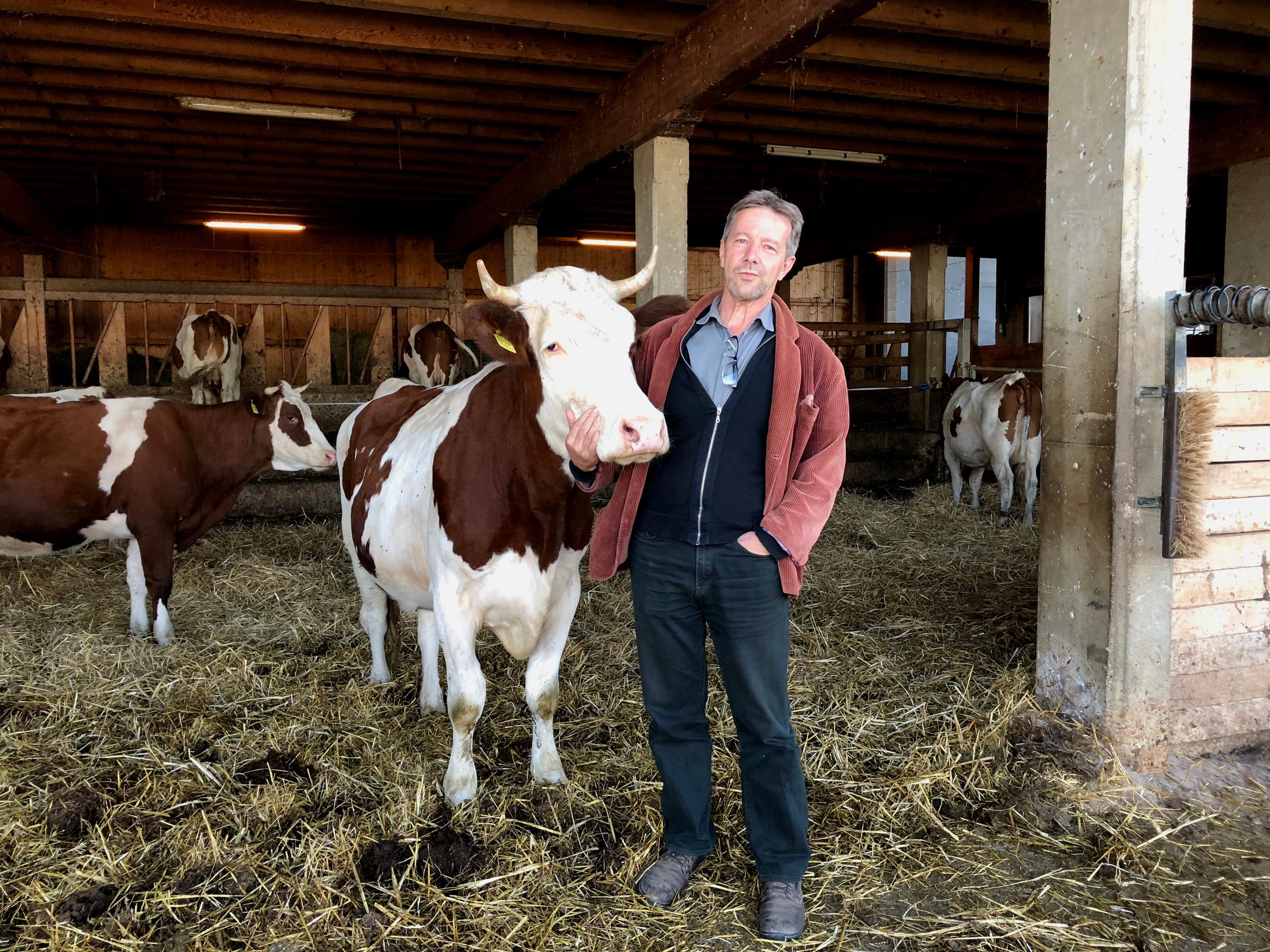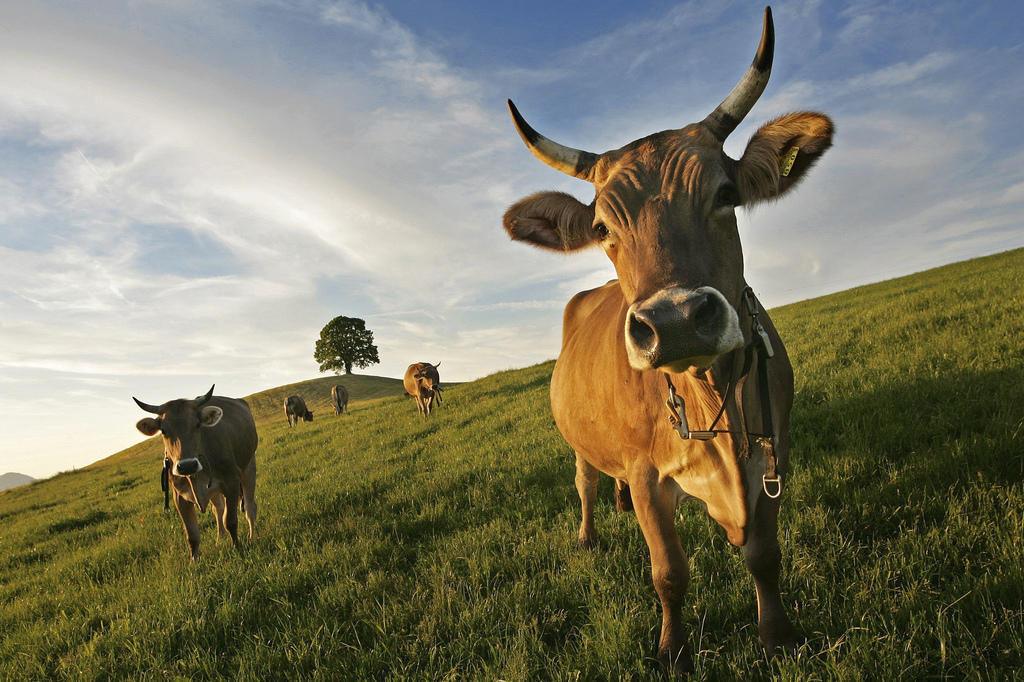
Swiss farmers divided over removal of cows’ horns
The question of cow horn removal, up for a vote in Switzerland, has revealed sharp divisions within the country's agricultural community. A visit to two farms reveals why.
Supporters of the cow horn initiative are calling for the Swiss constitution to be amended to introduce subsidies for farmers who do not remove the horns of their cows.
The leading Swiss Farmers Association has declined to take a position, preferring to leave the issue to a free vote. Two dairy farmers living in different parts of French-speaking Switzerland have starkly differing views on the issue.
“I remove my milking cows’ horns to prevent them from breaking and to avoid the animals injuring each other,” says dairy farmer Laurent Tornay who, together with his sons, runs a farm near Orsières in canton Valais.
Perched on a mountainside at 1,100 metres above sea level, Tornay’s farm La Rosière is accessible by a road that winds up an ever-increasing slope punctuated by breathtaking views.
“It is impossible to build a large, free-range barn here,” comments Tornay. His herd of 20 cows are kept in stables when they are not grazing, . Those that produce milk have been de-horned, but the six Héren cows are still in possession of their magnificent horns.
“A Héren cow without horns is not a cow,” says Tornay, explaining that the particularity of the breed is that they fight to establish a hierarchy within the herd. Even so, injuries are rare. “They are very docile, calm cows which are easy to manage even with horns.”
Tornay is the president of Agora, the umbrella organisation for French-speaking agriculture groups, which is against the cow horn initiative because, he says, “it has no business being in the constitution. People should be free to decide, we do not need to legislate on this issue”.
Footing the bill
Agora is also concerned about how the initiative, if passed, would be financed. The text does not provide for increasing the federal agriculture budget and money needed to support farmers whose cows have horns could be siphoned off from other farming subsidies, the organisation warns.
Banana or Fortuna: each cow at La Rosière has a name. Tornay loves his animals and is saddened when one of them is injured. That is why he decided, some 20 years ago, to de-horn his herd. Last summer, he was forced to call the veterinarian after one of his animals which had been sharing grazing pasture with the horned cows from another farm received a large gash on her flank that required eight stitches.
“This is distressing, we are attached to these animals,” says Tornay. “Without horns, the cows are calmer and there is less of a risk of injuries for them and us. They still establish a hierarchy by their attitudes and headbutts.”
The calves are de-horned during their early weeks and develop normally without horns, says Tornay. “The most important thing is the way in which we look after our cows. Here we caress them and when they are inside we brush them every day.”

“Horns are essential to the way a cow functions,” says Ueli Hurter.
He is one of the pioneers who developed the raising of cows with horns in free-range stables in Switzerland. In 1989 he took over the farm L’Aubier at MontézillonExternal link above Lake Neuchâtel.
When they are not grazing in the fields, his 24 animals roam freely in a large indoor/outdoor space. Each morning and evening they lumber into the milking shed, one after the other, at their own pace. Hurter manages his farm as an “agricultural organism”, by respecting the principles of biodiversity developed by Rudolf Steiner, founder of the study of anthroposophy.
“The farm is a living entity, with an equilibrium between the surface of earth available and the number of bovines,” he says. The animals eat the fodder, chewing the cud and digesting it before it is transformed into faeces which is returned to the earth as fertiliser.
“It’s a closed cycle,” says Hurter. “The earth does not get poorer, but richer thanks to the manure which gives it strength.”
Cows are therefore one of the pillars of this kind of farming. And so too are their horns.
Chewing the cud
Hurter approaches a cow that is chewing her cud. “She chews with intensity, concentration, as if she was eating her fodder.” The farmer explains that once a cow has chewed the cud, the grass releases gases inside her which travels to her nose and forehead. Hurter then takes a horn from inside his pocket to show its interior.
“It’s like a bone with large sinuses and an intense blood circulation. The tightness of the horns means the gases cannot be released and instead come into contact with the blood which returns this life force into the digestion and into the faeces. That is why this material is so powerful,” he says.
Hurter admits that this explanation is not scientifically proven, but he believes it nonetheless. Horns are important, he says, not only in aiding digestion but also for communication, enabling the animals to establish a hierarchy within the herd.
To have cows with horns in free-range stabling is therefore possible, “but you have to want it,” says Hurter. “You have to organise the stables differently, be more attentive, take the time to develop a social climate in the herd, manage the rhythm.”
Hurter does not avoid injuries completely, but he tries to limit them through good herd management and by filing the tips of some cows’ horns “like a pedicure”.
Hurter is convinced: “If we remove the horns, we remove from the cow a part of its way of being in contact with its exterior. She is diminished.”

More
Are cows happier with their horns?
Adapted from French by Sophie Douez/urs

In compliance with the JTI standards
More: SWI swissinfo.ch certified by the Journalism Trust Initiative





























You can find an overview of ongoing debates with our journalists here . Please join us!
If you want to start a conversation about a topic raised in this article or want to report factual errors, email us at english@swissinfo.ch.